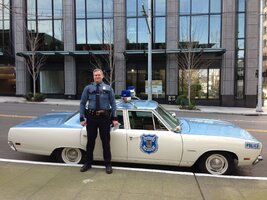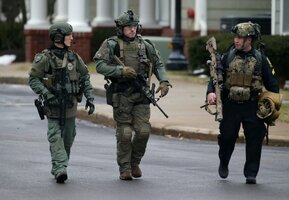Before I really start whinging, it's a useful remember that this is only the decision WRT the preliminary injunction, not the case itself.
Interestingly, like Heller before it, this may be the most direct route to SCOTUS. If the case goes against Hanson, et al., they're the only venue for appeal.
“When a multiple-round device like an LCM is attached, a handgun becomes a ‘semiautomatic’ weapon, meaning that it is capable of rapidly firing several bullets, one right after another. However, the gun still requires a trigger-pull for each round fired.”
Umm...no. That's not what makes it semiautomatic. But, we'll move on.
Still, the Circuit was not “certain” “based upon the record as it st[ood]” whether LCMs were in common use for lawful purposes—that is, “whether these weapons are commonly used or are useful specifically for self-defense or hunting"
Woah! Did y'all see those goalposts shift?
So nearly 1 in 5 magazines in the US in '94 were LCMs, and 4.7M more entered the country in the next 5 years. But we're not sure they're commonly used for lawful purposes...because the only activities that count are SD and hunting?
Ok. So we've accepted that magazines are arms (as concluded in Kolbe, etc.). Great.
We agree that they're commonplace, but will define "in common use" to actually mean "for self-defense."
Because defensive shootings that require more than 10 shots are "vanishingly rare" it must mean that LCMs are not commonly used for self-defense.
But defensive shootings
themselves are "vanishingly rare." If we hold ourselves to that standard, it would be enough to carry firearms without magazines - which you [the Court] just said would be inappropriate.
[Aside: Alito! Your "errant paragraph" is biting us again! I still don't understand how you got there, except to ignore Miller entirely.]
6 Plaintiffs also argue that LCMs are commonly used for lawful purposes such as training and competition. Pls.’ Reply at 11–12. But given that “individual self-defense is ‘the central component’ of the Second Amendment right,” it is unclear whether a weapon that is not typically possessed for self-defense may nonetheless be covered by the Second Amendment on the ground that it is typically possessed for sporting. Bruen, 142 S. Ct. at 2118 (emphasis in original) (citation omitted). The Court has no occasion to address that novel question here, because the Complaint and the motion for a preliminary injunction focus on Plaintiffs’ right of self-defense. See Compl. ¶¶ 27–36; Pls.’ Mot. at 7–14. Indeed, Plaintiffs’ counsel agreed at oral argument that Heller and its progeny focus on self-defense.
That's where the sleight of hand came from. Honestly, that's almost fair.
If the argument is "this ban implicates my right of self defense" then it's reasonable to define "lawful purposes" as "self defense."
That's kind of on the plaintiffs here. I haven't read/listened to the briefing, but if they didn't hammer on the fact that people train and compete with
the same pistols they carry and that, for those pistols, so-called LCMs are "design capacity," then that's on them.
Heller established that weapons that are “most useful in military service” are excluded from Second Amendment protection. 554 U.S. at 627 (emphasis added). “Most” is a superlative. A weapon may have some useful purposes in both civilian and military contexts, but if it is most useful in military service, it is not protected by the Second Amendment.
Dumb word games chasing preferred policy. You're hiding the (now-forbidden) second step inside your first.
The District’s expert, Brian DeLay, who has a Ph.D. in history and has extensively studied the history of firearms and arms trades, found that in the United States, “high-capacity firearms went almost exclusively to military buyers through the early 1870s and . . . very few were in the hands of private persons.”
Umm...no. (At least, in my understanding) Private citizens adopted lever-action rifles long before the US military. In fact, in that period, the US military continued to source single-shot rifles for fear that soldiers would waste ammo if they had repeaters...which comes up in a moment, with incomplete background.
(“Henry rifles were developed by the start of the American Civil War but were quite expensive—exorbitantly priced for regular rank-and-file troops—and did not see much combat. By the end of the hostilities, the War Department had only officially bought 1,731 of the guns.”)
Another missed opportunity by Plaintiff...
Moreover, these rifles did not resemble the semiautomatic weapons of today: they had fixed magazines, and “users of these ‘lever-action’ weapons were still required to pull a lever between shots, slowing the firing rate to about one shot every three seconds.”
Yes, slowing
by today's standards. When compared to contemporary options, they were
faster.
Because LCMs implicate “unprecedented societal concerns” and are the object of “dramatic technological changes,” the Court’s analysis of historical analogues to modern LCM bans requires “nuanced” consideration. Bruen, 142 S. Ct. at 2132. In what follows, the Court examines one such historical analogue that the District has proffered: numerous states’ high capacity weapon bans during the Prohibition Era
This is literally the balancing test that's defeated in
Bruen...
2. Whether Prohibition-Era Bans Are Historically Analogous
So Reconstruction-Era isn't good enough, we need to go to Prohibition? Almost as much of a dark spot in our history, and you risk implicating the entire NFA. It's a bold move, Cotton...
By defining “machine gun” broadly, these regulations revealed a widespread tradition dating back to the 1920s and 1930s of regulating high-capacity weapons that could fire rapidly without reloading
"[A] wide-spread tradition dating back" TO LIVING MEMORY!
This shows that the states confronted the public safety issues of their time with vigor; indeed, these regulations were at the time “obviously uncontroversial” from a constitutional perspective.
Hooray! Now, do "Ladder-Climbing." That "vigorous enforcement" was a dark period of creeping tyranny. Some of which we've overcome, and the rest we're still fighting.
But unlike “only three restrictions on public carry” that the government could produce in Bruen, which the Supreme Court “doubt[ed] . . . could suffice to show a tradition of public-carry regulation,” 142 S. Ct. at 2142, the District here has pointed to no less than six states plus D.C. that regulated semi-automatic and automatic weapons based on their high firing capacity
From "only three" to "six [...] plus DC." In 1865, there were 36 states (+DC); 3:37 is 8%. In 1930, there were 48 states (+DC); 7:49 is 14%. That's 75% more, but a small fraction.
...
Well, there's till the actual case to decide. Maybe they'll get a chance to revisit some of this better?
because the game dun changed. In the 70s the cops were fine with six shooter .38s and night sticks. Why do they look like airsoft delta force now?
View attachment 744423
View attachment 744421
emphasis on
Soft. An embarassment to the uniform, all of them.

![Stir the pot [pot] [pot]](/xen/styles/default/xenforo/smilies.vb/037.gif)

